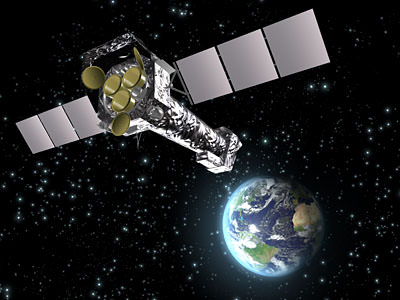[/caption]
XMM-Newton, the ESA’s premiere space-based X-ray observatory, will celebrate 10 years of spectacular X-ray imaging of our Universe today. On the 10th of December 1999 at 14:32 GMT, XMM-Newton was launched by the European Space Agency, and tasked with the mission of observing some of the most interesting objects in the Universe with its X-ray eyes. Many objects such as black holes and neutron stars have been studied using the telescope, because these energetic objects emit light in the X-ray spectrum.
To date, over 2000 published articles have utilized information from the XMM-Newton telescope. X-rays, a very energetic form of photons, are created in extreme celestial events, such as the disks that surround black holes and the intense magnetic fields surrounding stars. By studying the X-rays emitted by a variety of celestial objects, astronomers have been able to get detailed information about the workings of the Universe.
XMM-Newton has also been crucial to the study of galaxy clusters and supermassive black holes, and has helped to create the largest catalog of cosmic X-ray sources, with over a quarter of a million entries. It has even been enlisted in the hunt for dark matter, as one theory of the substance suggests that a decayed dark matter particle would potentially emit X-rays. Exotic objects far away aren’t the only target for the observatory, though; it’s helped astronomers detect the outer edges of the atmosphere of Mars and icy comets at the outer limits of our Solar System.
Here are just a few of the stories on Universe Today that feature observations by XMM-Newton:
- Pulsar Blasts Through a Ring of Gas
- Doughnut Around a Black Hole
- XMM-Newton Zeroes in on Zombie Star
- XMM-Newton Discovers Strange-Shaped Supernova Remnant
To celebrate the first decade of XMM-Newton’s observations, the ESA will hold a celebration in Madrid, Spain on December 10th. Here’s a link to XMM-Newton’s image gallery, and here’s one to a list of publications utilizing the telescope’s images.
Source: Eurekalert


Happy Birthday and Congratulations, XMM!!
Continue to work so well 🙂
I hope that a newer and better version of this craft is in the works. 10 years is approaching the life expectancy for spacecraft.
Where is XMM parked. Based on the picture it must be in geosynchronous orbit.
LC
Seems some artistic licence in the image. According to the wiki:
“It was placed in a very eccentric 48 hour elliptical orbit at 40°; at its apogee it is nearly 114,000 km from Earth, while the perigee is only 7,000 km”